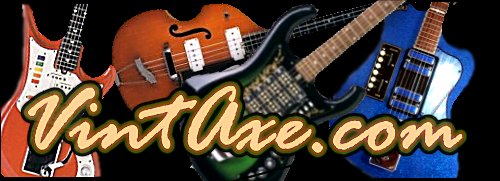
Guitars Sold on VintAxe
Alamo Fiesta ca. 1965 Alamo Fiestas were produced by Charles Eilenberg of San Antonio, Texas from 1962 to 1965. Fiestas featured the Acra-Tune bridge and the squiggly-tailed, fetus pickguards that are an Alamo trademark. This guitar is in great shape with a couple of dings on the front and some chips along the edges. The single coil pickups are very warm and coupled with a nice tube amp produce great tone, both for slide and lead playing, as well as chording. Along with Danelectro, these 60's Alamos are getting more respect for their unique tone among modern players. This one is all original and you'll be hard pressed to find one in better shape. It is a load of fun to play, kinda like a go kart guitar. For a full discussion of the role Alamo guitars played in the history of American guitar making see the Alamo chapter in Michael Wright's book, Guitar Stories: Vol. II. Original chipboard case included.
Greco model 910 c.a. 1967 Greco is the domestic brand name of Fujigen Instrument Manufacturing. In July of 1965 Fujigen stopped subcontracting the bodies and necks of it’s guitars from Matsumoku and opened a new woodworking facility equipped with state of the art equipment. This Greco 910 is an excellent example of what they were able to achieve with it’s German carved body (pre CNC), tight neck pocket and unusual headstock shape. This guitar is in excellent, original, untouched condition with a few dings and paint chips around the edges commensurate with age. On the front there is playing wear to the clearcoat where the arm would rest. On the back there is some light buckle rash and a finish scratch from the upper bout to the neckplate. The neck is a 42 layer hardwood laminate and fairly narrow for a guitar of this period. The fretboard is rosewood with some wear and the frets are still strong with even wear. The pickups were originally advertised as “top quality American style” although I think that is a considerable stretch; more like top quality Japanese single coils. The bridge is fully adjustable with a mute bar. The guitar ships in a brand new hardcase.
Kay K-2T ca. 1970 This is a Japanese built Kay. WMI of Chicago bought the Kay name in 1968 in order to gain access to the department store distribution relationships enjoyed by Kay. It is likely this Teisco made guitar was one of the first Japanese Kays imported by WMI after purchasing the Kay brandname. This instrument is essentially a Teisco Spectrum body and neck with a Kay “bushwhacker” style headstock profile. The body on this instrument is extremely clean with virtually no dents and only a few light scuffs around the edges. The neck is laminate and has a truss rod. The two pickups are controlled by on-off slider switches and single volume and tone knobs. The clamshell tremolo tailpiece is missing the whammy bar and spring but replacements are easy to obtain if you want to put it back in working order. It has what appears to be an original chipboard case.
Kingston Swinger ca. 1965 Kingston was the brand name Jack Westheimer applied to his Kawai built Japanese import guitars after he split with Teisco in 1965. This guitar is clean except for one dent above the pickguard on the upper bout on the front (see picture) and a paint chip at the top of the neck joint on the back side.The striped pickguard has a few light scratches but nothing too noticable.The neck is mahogany and the fretboard is rosewood.The chrome is clean. The pickups are controlled with on-off slider switches and a single volume and tone knob. This one has it's original whammy bar (a $40 value) that is almost always missing on these guitars. The guitar is priced with no case but I have a period hardcase that fits it perfectly for an additional $65 if the buyer is interested.
Teisco ET-230 Shark Fin ca. 1966 This is the two-pickup version of the "shark fin" style in a blue metallic finish with an anodized aluminum pickguard with stripes. It features a roller bridge, two single-coil pickups, a "zero" fret at the nut, and a spring-loaded tremolo (missing the bar but an exact reproduction is available for $30). Each pickup has its own on/off switch, along with separate volume and tone controls. There is also a separate rhythm/solo switch. All the electronics work properly. The open-gear tuners work fine, though a bit stiff in some places. The maple neck is straight with a rosewood fretboard and the frets have plenty of life left. The back of the neck has several dents but only one has resulted in paint loss. The body has a hand cut German carve around the periphery. There are several paint chips and bumps in the body mostly along the edges. The worst chip is on the edge of the lower bout near the output jack (see pictures). The back has no buckle rash although it does have a few scattered dents. Period chipboard case included.
Teisco May Queen c.a. 1968 The Teisco May Queen is the lowest priced model of the Teisco Holy quadruplets. There is the Spectrum 5, the Firebird, the Phantom and the May Queen. If you are interested in a May Queen I don’t need to explain it to you. This example is in the typical black finish with a single cutaway oval shaped semi hollow body, stylized "F" hole, 2 hot single coils and a vibrato. The pickguard is engraved "Teisco May Queen" and the engraving/paint is as clean as it gets. It has a bolt on neck with a dot inlaid rosewood fingerboard and smooth functioning closed back tuners. The action reminds me of a Rickenbacker but the style is all Japanese. Condition is very good and the parts are all original. It’s only flaws are significant chrome flakeing on the neck plate (see Back picture). Fortunately, these neckplates are generic and cheap ($10) on eBay if this bothers you. There is some light pitting on the whammy bar and several bumps on the headstock. The front of the body is generally clean with a couple of bumps and the back has moderate finish scratches with a few scattered bumps. Nothing significant for a guitar of this age. There is one scratch with some paint loss on the side at the back and some paint loss at the rear strap button. Priced without a case but if you want it shipped with a case just ask and we’ll fix you up at a very reasonable price.
Teisco ET-200 ca. 1970 Commonly known as a “Tulip”, this model Teisco was produced from 1969 to 1975. This guitar is original, intact and in good condition. It does have some paint rubbed off on the tip of the upper and lower horns (see picture) and a paint chip on the bottom edge right below the output jack. The action is good and the intonation is decent with the low E and A strings going about 1 cent sharp at the twelfth fret. Overall a fun little player for very little money. In fact, it’s priced for what the hardware would sell for on eBay, I just can’t bear to part out a perfectly good instrument. Priced without case but I can supply a period chipboard case for $55 if desired.
Teisco M-200 ca. 1970 This instrument is essentially a Teisco Spectrum body and neck with different pickups. The body on this instrument is very clean with minimal dents and scuffs. The neck is laminate and has a truss rod. The two pickups are controlled by on-off slider switches and single volume and tone knobs. The clamshell tremolo tailpiece is fully functional and works well in conjunction with the roller bridge. It has what appears to be an original two tone chipboard case.
Teisco Telecaster ca. 1972 I’m not sure the exact year this Telecaster copy was made but I’m pretty sure it is before 1974 since Teisco was copying the Telecaster style headstock in their 1974 catalog. This guitar has the rarer “Teisco” style headstock with a 1970’s style Teisco badge. The body only has a couple of paint chips but it does have several tight finish cracks from the body wood expanding and contracting over the years. The neck is three piece maple with no dents and the fretboard is rosewood. The pickups are controlled by two on-off slider switches and the different pickup configurations along with the tone knob provide a wide range of tones to choose from. The bridge is fully adjustable and the neck has a truss rod. The action is set low and the intonation is spot on. The clamshell tremolo tailpiece is missing the whammy bar but a replacement is easy to obtain if you want one. No case.
Unknown Flying V ca. 1970's - 80's? I really don’t know the first thing about this V other than it is very clean and fun to play. It is either Japanese or Korean but I can’t say for sure which. The body is laminate construction with a transparent cherry finish. The finish is in Excellent Plus condition with only a few small chips on the sides and back. The neck has a rosewood fretboard and the action is low and even up the neck. The chrome on the tuners and bridge is clean. Each humbucker pick up has a distinctive voice and the electronics are quiet and hot. The bridge is fully adjustable and the gold Gibson style speed knobs look great against the black 3 ply pickguard. This guitar is much cheaper and nicer than the new Chinese stuff being sold today. No Case.
Hagstrom 1 ca. 1966-67 According to the serial number, this Hagstrom I was one of 958 guitars produced in 1966-67. The Hagstrom I was introduced in 1962 as Hagstrom’s budget model. The body is made of laminate board covered in vinyl. The front is made from acrylite and contains the pickups, electronics and controls all in one piece. The neck is birch with a teak fretboard (24.5 inch scale). The trussrod is Hagstrom’s proprietary “H” expander-stretcher. The two single coil pickups are controlled by a single volume control and 4 switches. The switch marked mute is actually another tone modifier, not an on-off switch. The “cheese grater” between the pickups is gold plated aluminum. This example is in Excellent condition. It has two small chips in the paint on the back of the neck and some chips/rub wear on the headstock. The vinyl back is tight and clean with no shrinking. The front has a small rub spot on the upper and lower horns. The electronics function normally and are shielded in foil. The action is low and even up the neck with good intonation. Comes with it’s original chipboard case.
Teisco EP-9T ca. 1969 This is a clean example of the EP-9T in a sunburst finish. The guitar has a laminate neck with a truss rod and a rosewood fretboard. The pickguard and pickup surrounds have a rich tortoise marbling. The front is fairly clean with a couple of tight stress cracks in the clear coat finish. The back has light scattered scuffing with a bit of superficial buckle rash in the center and a couple of stress cracks in the clear coat finish. The guitar setup would benefit from a neck shim to make the action even all the way up the neck but it plays fine if you are an open chord type of player. Dreadnought style chipboard case included.
Domino Californian ca. 1967 Domino was a short-lived brand name applied to guitars manufactured in Japan by both Arai and Kawai in the late 1960's. Dominos were imported into the U.S. market by the Maurice Lipsky Company of New York. This Domino Californian was a copy of a Vox Phantom VI and was manufactured by Kawai in 1966-67. The body is made of mahogany finished in a very attractive tobacco burst color. The neck is maple with a bound rosewood fretboard and has an adjustable truss rod. The guitar is fitted with 6 on plate open gear machines, an adjustable bridge and all chrome hardware. The two single coil pickups are controlled by one volume and one tone knob. The three slide switches at the bottom allow the player to select different pickup configurations. This guitar is in near mint condition; I think you could look for years and not find a nicer one. Original chipboard case included. Conqueror Bruno 1202T ca. 1967 Throughout their history, Bruno musical instruments were manufactured by other companies and then distributed by C. Bruno & Son. In the late 1960’s, C. Bruno & Son imported their instruments from Matsumoku, a large Japanese manufacturer and exporter. Matsumoku also built guitars branded Aria, Ventura, Lyle, etc. and produced guitars that are generally well regarded today. This Gibson ES-335 copy guitar is a very well crafted three-tone sunburst hollow body containing two single coil pickups controlled by two volume and two tone controls via a 3-way pickup selector switch. The body, f holes, neck and headstock are completely bound. There are a few tight stress cracks in the clearcoat of this instrument that is typical for these hollowbodies. The selector switch and headstock are covered with the same red tortoiseshell plastic used for the pickguard. All electronics function perfectly. The neck is made from 2 pieces of wood joined at the truss rod channel and attaches to the body with four bolts. It appears to have been shimmed at some point, making the action low and even up the neck. The fretboard is rosewood. The top and back of the body are each made from a single slab of wood (birch ply?). The chrome on all the hardware is bright and clean. It is missing the whammy bar (typical). The roller bridge is fully adjustable. No Case.
The Guitar Kawai unknown model ca. 1967 This unknown model Kawai is remarkably clean, no chips, no dings, no buckle rash, only light surface scratches in the clearcoat. The neck is mahogany and has good intonation although a few strings go a cent or two sharp by the time you get to the 12th fret. The hardware and electronics are all original and the chrome has no pitting. I love the pick guard on this guitar, it is deep, rich and remarkably beautiful. Overall, this is a very nice example of this Kawai model. I have a 60's Vox hardshell case that fits this guitar perfectly for an additional $75
Teisco EB 220 Shark Fin Bass ca. 1966-67 A very nice example of the Teisco EB-220. It has a 3 piece laminated neck with a rosewood fretboard and the fancier fan inlays (most EB220's have dots) The tobacco burst mahogany body is finished in multiple coats of warm lacquer. Between the tone control and the pickup switches, this bass is capable of producing a variety of interesting tones. The hardware is all original, however, it is missing the tailpiece cover (typical) and the headstock badge. The front is very clean with only a few small bumps but the back has a bit of buckle rash that is well represented in the pictures. The action is good and the intonation is close but not perfect, however, between the truss rod and the adjustable bridge the intonation can be tweaked to perfection. Overall this is a fine example of a classic Teisco shark fin bass that is becoming harder and harder to find in this condition.
Heit Deluxe ca. 1968-70 This guitar has been badged "Valiant" but it's unmistakable body contours reveal it's true identity as a Heit. G&H Imports of Lodi, New Jersey imported these guitars from Japan in the late 1960's. The body is finished in metal-flake blue with a couple of chips at the "hook" on the butt of the guitar. The clear coat has uniform crazing throughout but the actual paint finish is tight and unaffected. The neck is mahogany with a rosewood fretboard and MOTS dot markers. The frets are generally good with the exception of the first fret that has grooves from playwear. This doesn't affect playability as open chords still fret just fine. The pickguard is stunning! It is 4ply in beautiful reddish-amberish tortoise. The three switches at the bottom of the pickguard are on-off switches for the three pickups allowing you to dial up the pickups in any combination you choose. The pickups are hot single-coils that refuse to clean up at any setting. Although a variety of tones are possible they are all dirty with lots of sustain; reminds me of playing through my Big Muff. The guitar stays in tune remarkably well given the budget tuners and the intonation is within a cent or so at the 12th fret. As with most of these guitars, the neck would benefit from a thin shim but it is very playable as it is. The condition is original but it does lack the whammy bar. No Case.
Teisco ET 200 ca. 1973 Wow, if you are looking for a sunburst ET-200 with tremolo you will be hard pressed to find one cleaner than this guitar. Other than a couple of bumps, light scratches and a little rubbing on the edges this guitar could have rolled off the Teisco assembly line last week. It is all original, with bright chrome hardware and a "steel reinforced" laminated neck (no truss rod) with a rosewood fretboard. I'll let the pictures do the talking on this one.
Danelectro Innuendo ca. 2001 My son purchased this guitar in high school. He loved it until the battery ran out on the effects and he then moved on to another guitar. I guess that is my curse for having too many guitars in the house. Anyway, this instrument is essentially brand new, it even has its' original hang tags. Since condition is "as shipped from the factory", I'll send you to the Vintage Guitar Magazine Review to get the scoop on it's features. VG Innuendo Review. I have no case.
Truetone Archtop ca. 1966 Cool Super Auditorium Standard Archtop acoustic made by Kay and sold through Western Auto stores in the 1960's. Has a steel reinforced neck made of walnut and the body wood looks like birch to me. It is all original, and plays great with even action and decent intonation all the way up the neck. As far as flaws, there is some light fingerboard wear up to the 3rd fret and a mark on the front lower bout of the body that may be due to the pick guard rubbing against the wood. The pickguard is missing but it should be fairly easy to find a replacement. I have pictures of the original pickguard if needed. The body and neck have a few bumps and bruises but nothing out of the ordinary for a 40 year old instrument. There is also some label glue residue on the back of the headstock (see pic) that I haven't tried to remove. Overall, this is a very nice budget acoustic archtop that is loud and a load of fun to play.
Teisco EP-8T ca. 1970 This is a very clean example of the EP-8T in a translucent black finish. In low light, the guitar looks black, but in strong light you can see the grain through the translucent finish. It is impressive for a Teisco finish. The guitar has a laminate neck with a truss rod and a rosewood fretboard. The pickups are "Spectrum", same as they put in the solidbody electrics of this era. The front is fairly clean with a couple of stress cracks in the clear coat finish. There is also a small bubbling in the finish on the lower bout that can be seen in the "body" photograph. It looks like someone has held a cigarette too close to the clear coat. This might buff out. The back is very clean with no buckle rash and one 3 inch stress crack in the finish. This EP suffers the "top dip" at the treble pickup that is common to virtually all these instruments. It will need a neck shim to make the intonation right all the way up the neck but plays fine if you are an open chord type of player. It is a wonderful relic that deserves the neck shim it needs to be an excellent player.
Picture 2 Picture 2
Copyright © 2000-2003 VintAxe.com Vintage Guitars All Rights Reserved.
VintAxe.com logo design by Oh Wow! Graphics - ohwowgraphics.com
Title and Picture Description Price Contact 
Sold Steve 
Sold Steve 
Sold Steve 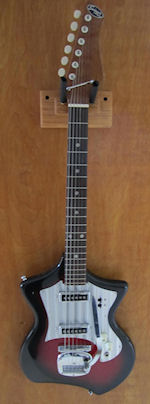
Sold Steve 
Sold Steve 
Sold Steve 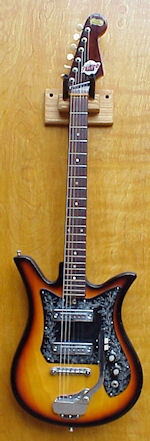
Sold Steve 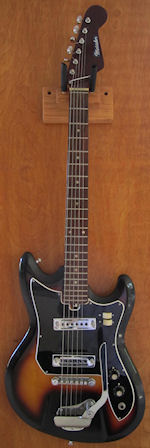
Sold Steve 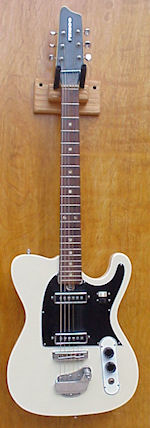
Sold Steve 
Sold Steve 
Sold Steve 
Sold Steve 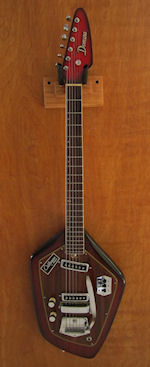
Sold Steve 
The Body
The Headstock
The Tuners
The Back
The Neck PlateSold Steve 
Sold Steve 
Sold Steve 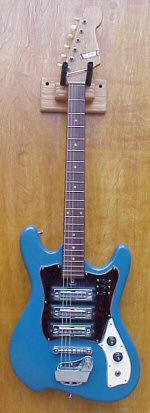
Sold Steve 
Sold Steve 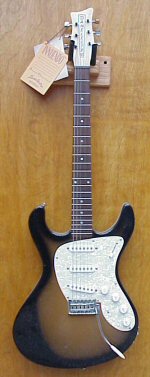
Sold Steve 
Sold Steve 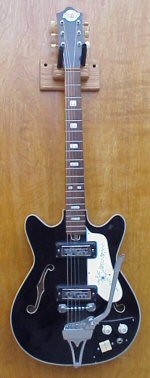
Sold Steve Coral FireFly by Danelectro ca.1967-69 Early original Danalectro Coral Firefly. This is the "Vincent Bell Signature Series" as shown on the clear pickguard. This guitar is in very good condition and looks like new in person. There are a few minor surface finish cracks on the front and a small blemish on the back outer edge. The neck is straight and not worn. In fact I don't think this guitar was played much. It features two Danelectro lipstick pickups, a clear pickguard, a Bigsby that looks brand new and Kluson tuners. Musicians describe this guitar as sounding mellow blues and jazz like, more like a Gibson than a Fender. It comes with it's original form fitted hard-shell case with gold interior. Be sure and check out the pictures for more details....More Pictures Sold Kawai MS 170 ca. 1968 The Kawai MS 170 is a copy of the Vox Mark VI made famous by Brian Jones of the Rolling Stones. This instrument has a spruce top with mahogany back and sides. The back has shrunk slightly with age creating a small ridge (1/32) between the back and side binding on the lower bottom bout. The finish has lacquer cracks commensurate with age but there are very few dings and dents in the finish. The only notable nick on the top is directly above the bridge and could be filled with lacquer and buffed out to near invisibility if wanted. The body, neck, and f hole are fully bound. The neck is straight with good intonation. As with most of these instruments, the action would benefit from a shim in the neck but it's really quite acceptable now (3/32 at the twelfth fret). The rosewood fretboard is clean and the first three frets show some wear but nothing out of the ordinary (no buzzing). The zero-fret is grooved to the point that it will ping when you bend strings but this isn't audible through an amplifier. The hardware and electronics are all original. The bridge pickup is noticeably stronger than the neck pickup, however, the neck pickup still produces good tone. The chrome is all very clean with only light speckling on the tailpiece. The pickguard is not original but it is the correct Mark VI configuration. The original pickguard was set up similar to an archtop so there is a screw hole for the original bracket in the bottom side panel. The current pickguard lays flat on the body like the Vox Mark VI's and has the same profile as the Vox models. Overall, this is a very nice example of a rare Kawai model. Sold Steve EKO 500 4V ca. 1963 The plastic covered EKO 500 was the flagship model for EKO from the time they were introduced in 1962 until they were discontinued in 1965. This guitar exhibits a Silver Sparkle top with Black back finish on a contoured, Jazzmaster style body. The finish is excellent with the exception of a 1cm scuff on the bottom lower bout and a scuff on the back that can be seen in the picture and is located on the upper bout. A small 1 1/4 inch section of binding has been repaired with a piece that is not an exact match but probably as close as possible without original material. There is also a small strap button screw hole in the binding on the bottom lower bout indicating that the guitar may have been set up as a lefty at some point in it's history. The pickguard is about as cool as they get with vivid striping throughout. The neck is a 25 inch scale with twenty one frets that are still in good condition plus a zero fret. The guitar has a rosewood fretboard in unworn condition and EKO's famous airplane propeller inlays. The four "Double Polarity" Alnico pickups are controlled by single volume and tone knobs as well as six sliding switches along the top of the pickguard. According to EKO sales literature, the preset tones include: M= Full-Guitar, 1 = Jazz, 4 = Twang, 1+4 = Take-Off, 2+3 = Full-Rhythm, and 0 = Off. The hardware is original except for the tune-o-matic bridge upgrade that sits on the original posts. This guitar is an early model 500 since the tailpiece sits on top of a plastic rather than a metal base. These early models are scarce; this one is set up, strobed and ready to play at a very good price.
Sold Steve Kawai ca. mid 1960's I'm really not sure about the manufacturer or model of this mid 60's MIJ guitar but based on style I'm guessing it is a Kawai. I have seen this guitar with a "Barth" headstock logo if that helps anyone with identification. The headstock has the shadow of a logo that appears to have been an unfurled scroll. As for condition, the lacquer finish on the body has several age cracks and there are a variety of chips and dings around the edges of the body typical of a 40 year-old instrument. The headstock has a couple of very tight cracks that are not structural and can be seen clearly in the pics. The neck and fretboard are in good shape and the frets show even wear with plenty of life remaining. The intonation goes a few cents sharp as you move up the neck and registers 2-3 cents shape at the 12th fret depending on the string. This issue can be corrected by replacing the current bar bridge with an adjustable bridge. The other tuning issue is with open chord pulling a little sharp indicating the nut slots need filing. The only other issues with this instrument are that the knobs are not original (Nobease brand) and the knobs on the tuners look a little too bright to be original. The good news on this instrument is that it has two "Ry Cooder" gold foils pickups in it that sound great. I've seen these pickups sell for up to $80 apiece on eBay and that pretty much covers the price of admission on this guitar. The chrome pickguard is clean and bright; you can see that it reflects my garden just great in the pictures. Overall, this is a cool little 60's guitar that can be a fine player with just a little TLC. I've just got too many guitars that need TLC right now so I'm going to let this one go cheap and let the new owner have the joy of loving it. The guitar will repay your efforts with a wonderful warm vintage tone for your recordings.
Sold Steve Kawai S-170 ca. 1964 The Kawai S-170 is known as the "Hound Dog Taylor" guitar since Taylor is pictured with this instrument on the cover of his Hound Dog Taylor and the Houserockers album in 1971. This guitar has a mahogany body with a maple neck and rosewood fretboard. The lacquer finish has honest playwear on the front upper bout but the stain is still intact. There are several edge chips, mostly on the lower back edge but nothing out of the ordinary for a 40-year-old guitar. The neck on this instrument has been reset so the action is low and even up the neck with great intonation, however the neck adjustment has created a 1mm gap where the neck joins the body. This guitar has been modified to be a player, not a wall hanger. The original bridge has been replaced with Schaller bridge-tailpiece assembly that has individual fine tuners ($55). The original plastic rocker switches for pickup selection have been replaced with individual toggle switches that are both quieter and more reliable. Both of these modifications have been professionally done and I don't think either detracts from the vintage vibe of the guitar; people unfamiliar with the original probably wouldn't notice the mods. The chrome pick covers have surface pick scratches but are still bright and oxidation free. The tone and volume knobs are original as are the tuners. Very, very cool tones out of the single-coil pickups, check out the Houserockers record to see what I mean. If you've been looking for a Hound Dog Taylor reliable enough to play out and record with rather than hang on the wall, look no further, this one can be taken to a gig as soon as you pull it out of the box.
Sold Steve Mapleglow Rickenbacker 360 Guitar (ca. 1996) This is a Standard Rickenbacker 360/6 in a Mapleglo finish with a maple bound body and neck. It has a polished rosewood fretboard with 24 frets and is inlayed with triangular pearloid markers. The hardware includes Schaller tuners, chrome R tailpiece, 2 high gain single coil pickups, 2 volume/tone controls, and a blender knob. It has Ric-O-Sound and Standard output jacks. The special contour around the entire body perimeter makes the guitar very comfortable to hold and the action is like butter. Recently set up. Very minor scuffing/pitting. Comes with original case.
Picture 3
Picture 4
Picture 5
Picture 6
Picture 7
Picture 8
Picture 9
Picture 10
Picture 11Sold Don Aria Pro II Urchin U-60T ca. 1982 Introduced in 1982, the U-60T Urchin was one of the first B.C. Rich inspired pointy guitars on the market. The U-60T has an alder body that came finished in either Black or White. The finish on this guitar is in excellent condition with one small chip on the tip of the upper back wing. The guitar is missing the two small bumpers on the ends of the wing tips but these were clearly not very durable since I've never seen intact bumpers on an Urchin, just the remains of the screws. There are two stress cracks in the finish on either side of the neck (typical for these instruments) but the cracks are not structural. I know this because I pulled the neck when setting it up to make sure everything was OK. The maple neck is fitted with a 25 1/2 scale rosewood fretboard that shows little wear. The frets have moderate wear but still have plenty of life left in them. The action is low and even up the neck and the guitar has been professionally strobed and adjusted so it's ready to play. The headstock is fitted with chrome plated die cast machines and a bone nut. The humbucking pickups are two Protomatic-V's selected by a 3-way switch and controlled by one master volume and two tone knobs. The pickups are great shredders at high gain and clean up nicely at lower volume. The pole screws show pick wear on the 2 inside pickups. The bridge assembly is a chrome plate through the body stringing system with vibrato unit. This instrument is missing the vibrato bar that looks like a longer and less bent Fender Stratocaster bar. The Urchin was only made from 82-84. It is a rare and very cool pointy guitar that is currently undervalued in today's market. You won't be able to get one this nice at this price for very much longer.
Sold Steve Conrad CSG-? guitar ca. 1965 This Conrad/Baldwin is a handsome red sunburst. Everything works and it has been recently set up. The switches that control the 4 pickups have been replaced (no extra holes or any other modification made to guitar) but the vintage originals are included. The neck is straight, clean, fat and round. There are scratches and scuffs on the body but no major chips nor is anything broken. Comes with brand new gig bag. Sold Don White Hagstrom I White Hagstrom I with original case. Hagstrom guitars were built in Alvdalen Sweden from 1958 to 1981 and sold in the US by Merson Musical Instruments of New York. Manufactured from 1962-1966, Kents are advertised as “having the worlds fastest playing neck”. They feature vinyl covered backs and Lucite covered fronts that were produced in red, black, white, lavender and orange. It is not unusual for the vinyl backs of these guitars to shrink and pull away from the hard plastic top creating a difficult repair problem. However the necks are extremely durable and the fretboards are made of teak. The distinguishing “cheese-grater” between the pickups makes for a cool looking vintage style and a great surf tone. Hagstrom Gitarrer, a publication documenting the history of Hagstrom guitars, shows there were 14193 various Kent models produced from 1962 through 1966. (Information provided by the Hagstrom USA webpage) Guitar plays great and has been recently set up. There were some shallow gouges on the back of the neck that have been professionally repaired. The rare backing is intact. It soft and has some wrinkling and wear. Please see pictures. Rock and roll combat paint wear in many places. Again, please see numerous pictures.
Picture 3
Picture 4
Picture 5
Picture 6
Picture 7
Picture 8
Picture 9
Picture 10
Picture 11
Picture 12
Picture 13Sold Don Teisco Del Ray ET460 ca. 1967 The ET-460 or "Shark Fin" guitar is one of the most recognized Teisco models having been played by David Lindley, Ry Cooder, Hound Dog Taylor and others. This guitar is a good looking and excellent sounding player. It has been professionally refinished years ago, that's why you've never seen one this color. When I showed it to my luthier Keith and told him it was a refin his response was "really? looks good". The refin is given away by 4 chips scattered around the back edge of the body where the original blue finish shows through, the worst being about 1.5cm on the bottom of the lower fin. The 3 piece laminated neck is straight with good intonation and action up the neck. The striped pickguard has a few scratches, the worst one can be seen in the photograph on the bottom lower fin. The rotary selector switch has been replaced with a 3-way toggle that looks the part and as usual, the bridge and tailpiece covers are missing. The chrome is clean and need I say, the pickups sound great! If you want a guitar for the museum this is probably not your instrument but if you want an excellent player you're not afraid to take out of the house, this is a great one. The reissues cost $500, this one is set up, strobed and ready to go for a lot less dough.
Sold Steve Teisco WG4L ca. 1965 A nice example of this classic Teisco model badged Silvertone in a beautifully aged cream finish. The paint on the front is clean with just a couple of whiskey dents. There is no buckle rash on the back, but there is moderate paint chipping, mostly located on the back edge of the lower butt end. The back of the neck has a few impact dings but the paint is intact. All hardware is intact, original and works fine. The controls and switches are quiet, and the pickups are strong. There is light speckle pitting on the whammy bar but the rest of the chrome is clean. The neck is straight and the frets are generally evenly worn with no fret-out anywhere on the neck. The intonation is quite good for a Teisco and it is very playable as is, however, a shim in the neck ($15) would help the action up the neck as well as the intonation if you want to make it perfect. This guitar is a tone machine! The four pickups along with the bass boost switch and tone knob allow you to dial in a variety of very useful tone options. This guitar sold for $149 in 1965 that is $885 in today's dollars. Gruhn's has an identical guitar in slightly better cosmetic condition listed for $600; my overhead is a little lower. Korean hardcase in excellent condition included. Sold Steve Teisco ET-440 ca 1969 Most guitar historians consider the ET series guitars the last of the Teiscos. Emerging in late 1969, early 1970, these guitars represent the movement from the old Teisco line to the "copy era" of Japanese guitar making. This ET-440 has a strat style body, four "spectrum sound" pickups, a laminated maple neck (Framus inspired?) and a wood grained faced strat style headstock. The condition of this guitar is good, but it does have some issues. First, there are 2 surface cracks on the top of the guitar, one at the upper bout and one between the tailpiece and bridge. They are not deep but they do penetrate to the wood slightly. The body has other scuffs and small dings commensurate with age. Paint on the floral pickguard is worn and there are a couple of pickguard screws missing. Also missing is the pickup selector tip (typical) and one of the pickup switch covers (available on eBay). The two front pickups are a little loose in their mounting, a problem that someone has tried to solve by wedging a fold of paper between the pickup and pickguard. This could be fixed right by removing the pickguard and using some surgical hose on the mounting screws, I just haven't bothered. The frets are also a bit worn, but they are even and have plenty of life left. Now for the good news. The laminated neck has stood the test of time and is straight with good intonation. The neck feels great and is in excellent condition. Both the Teisco logo and whammy bar are intact. My son likes to tune this baby to drop D and flail away on Korn stuff, it's got good grunge tone. Sold Steve Heit Deluxe Late 1960's Heit Deluxe was a badge placed on Teisco made guitars by an unknown American importer. This one is about as clean as you will ever find since most were beaten into submission by prepubescent boys in the early 70's. The finish on this example is immaculate with only light scuffing and a very light 1/8 inch line ding on the edge of the upper rear bout. The back has zero buckle scratching and only a few light scuffs. The only finish flaw on the guitar is a very small chip on the lower side of the headstock which could be touched up to invisibility if you wanted the guitar to be perfect. The neck is straight with plenty of fret life left and the pickup has a great surf tone. The intonation is a little funky as the note will go a few cents sharp as you move up the neck to the 12th fret. This may be compensated for by a neck tweak or may require replacing the nonadjustable bridge with an adjustable model. Stew-Mac offers a replacement that will fit the current posts without altering the guitar for around $15. This guitar is a cool little player, I'd keep it if I had the space to display it. Sold Steve Alamo Fiesta Mark I Model 2484W, ca.1964 Alamo Fiestas were produced by Charles Eilenberg of San Antonio, Texas from 1962 to 1965. Fiestas featured the Acra-Tune bridge and the squiggly-tailed, fetus pickguards that are an Alamo trademark. This guitar is in great shape with very few surface scratches on the front and only slight buckle rash on the back. It is currently set up for slide playing since the nut has been raised slightly by inserting two small spacers underneath it, these could be removed easily. The single coil pickup is hot and produces great tone, both for slide and lead playing, as well as chording. This one is all original and you'll be hard pressed to find one in better shape. It is a load of fun to play. For a full discussion of the role Alamo guitars played in the history of American guitar making see the Alamo chapter in Michael Wright's book, Guitar Stories: Vol. II. Sold Steve 1965 Kent SG Hollowbody This Kent is missing the pickguard and someone has painted a binding around the F-Holes. The metal panel that the knobs sit on has a screw on one corner that is loose. All of the electronics work and the action is easy. The treble pickup is pretty tinny so I always use the bass pickup and like it. The finish shows typical play wear - scratches and nicks that are mostly on the back. There are also typical finish "cracks" in several places. The intonation is good. The guitar was set up with new strings about 4 months ago. Sold Don 1969 Teisco Del Ray E-110 Was this your first guitar? This is a nice example of the E-110 from about 1969. Does have some very small scratches and nicks with the exception of one horn which has a small gouge. The floral pickguard is very clean. It will need to be adjusted or set up as there is some buzzing on some strings. Missing both strap holders. Sold Don 1967 Arai Diamond 1402T Hofner 6 String This hard to find Hofner copy made by Arai is missing the headstock logo, whammy bar, 1 pickup doesn't work and I was told that the truss rod has a slight bend in it. The good news? It's a beautiful looking guitar, the pickup that works sounds great and there are no intonation issues until you get close to the 12th fret. There are some very minor scratches and some dings at the tip of the headstock. It has been freshly restrung. Sold Don 1965 Teisco Del Ray ET-310 This little beast has a nice fat neck, great action and a wonderful range of tones. Features the whacky 4-3 tuning key configuration, striped aluminum pickguard and push button pickup selector switches. Missing the whammy bar. The headstock badge is clean. There are minor to significant dings and scratches on the body and neck. This is not the guitar to use to get girls with unless you are going to bonk them on the head with it caveman style. You could put stickers on it and spray paint it with scary symbols. It will still sound good. Sold Don